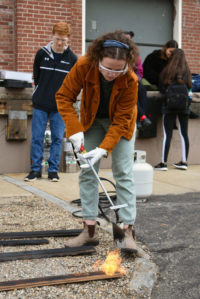This week, some of the architecture students began their Tuesday with a little more excitement than their usual early morning lecture. Instead of spending their class period indoors, they formed a circle around planks of cedar, a propane tank, and a blow torch in the parking lot behind Ryder Hall. As the class of both sophomores and graduate students gathered around to figure out the day’s activity, each one was instructed to pull on a pair of fire-resistant gloves and slide on protective eye gear. Northeastern Architectonic Systems professor, Peter Wiederspahn, and Maker Space manager, Patrick Kana, were both excited to begin teaching the students the intricacies of a long-established Japanese wood preserving technique.
One by one, the students took turns handling the propane torch and creating a unique ebony stain by charring their cedar wood panels. As each student moved the torch slowly across their panel, it blackened and formed different impressions on the wood’s surface. Wiederspahn referred to the materializing texture as “gatoring” because of its striking resemblance to the pattern of alligator scales. Once the piece was charred consistently on the outside, the students took it out from under the heat to remove the remaining layer of charcoal. Whispy clouds of black dust flew into the air and settled onto the ground as they used brushes to sweep along the panels’ now jet-black exterior. This last step was done very carefully by each student to preserve a portion of the gatoring on the panel. They each repeated this process until each wooden panel was passed over twice with the torch and twice with the brush. After completion of the morning’s venture, the panels were lined up parallel to one another and admired for their overall consistency, but upon closer inspection, their unique individuality.
The inspiration behind this fiery endeavor comes from Wiederspahn’s involvement in curating an exhibit with fellow Northeastern architecture professors, David Fannon and Michelle Laboy. Wiederspahn, Fannon and Laboy are selecting masonry, steel, concrete, and wood pieces to showcase at the Boston Society of Architects in the upcoming spring for the Durable: Sustainable Material Ecologies, Assemblies, and Cultures exhibition. These student-made wooden panels will be on display as a representation of a traditional Japanese process called Shou Sugi Ban. This practice involves burning the exterior of wood panels used for the external siding of buildings. It has been widely used in Japanese history to not only create a beautiful individualizing finish, but to weatherproof the wood’s surface. Shou Sugi Ban is not a complicated process, as it only requires two steps that are to be repeated. It’s simplicity, functionality, and variability are what make it so interesting to not only watch, but to admire its finished, preserved beauty.








